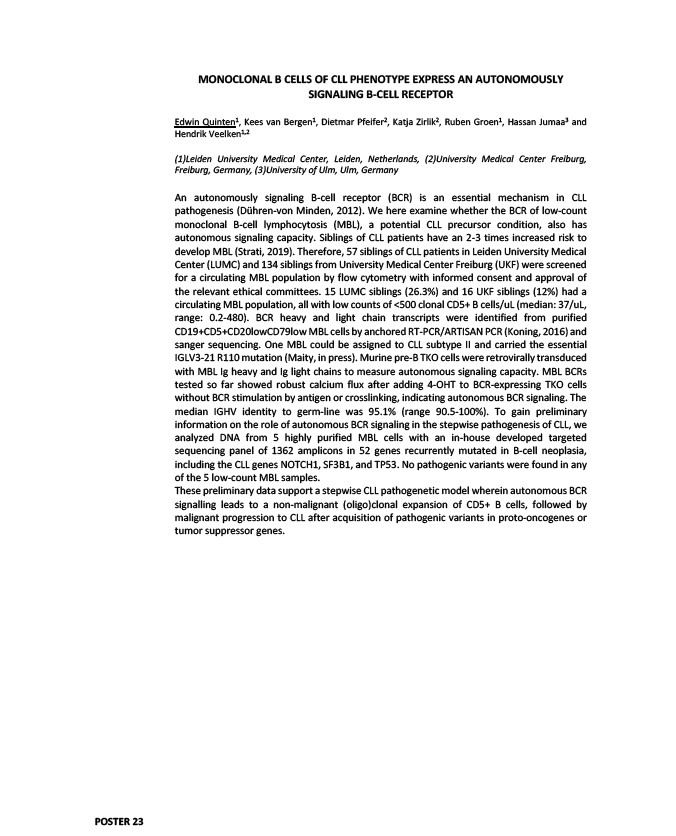
MONOCLONAL B CELLS OF CLL PHENOTYPE EXPRESS AN AUTONOMOUSLY
SIGNALING B-CELL RECEPTOR
Edwin Quinten1, Kees van Bergen1, Dietmar Pfeifer2, Katja Zirlik2, Ruben Groen1, Hassan Jumaa3 and
Hendrik Veelken1,2
(1)Leiden University Medical Center, Leiden, Netherlands, (2)University Medical Center Freiburg,
Freiburg, Germany, (3)University of Ulm, Ulm, Germany
An autonomously signaling B-cell receptor (BCR) is an essential mechanism in CLL
pathogenesis (Dühren-von Minden, 2012). We here examine whether the BCR of low-count
monoclonal B-cell lymphocytosis (MBL), a potential CLL precursor condition, also has
autonomous signaling capacity. Siblings of CLL patients have an 2-3 times increased risk to
develop MBL (Strati, 2019). Therefore, 57 siblings of CLL patients in Leiden University Medical
Center (LUMC) and 134 siblings from University Medical Center Freiburg (UKF) were screened
for a circulating MBL population by flow cytometry with informed consent and approval of
the relevant ethical committees. 15 LUMC siblings (26.3%) and 16 UKF siblings (12%) had a
circulating MBL population, all with low counts of <500 clonal CD5+ B cells/uL (median: 37/uL,
range: 0.2-480). BCR heavy and light chain transcripts were identified from purified
CD19+CD5+CD20lowCD79low MBL cells by anchored RT-PCR/ARTISAN PCR (Koning, 2016) and
sanger sequencing. One MBL could be assigned to CLL subtype II and carried the essential
IGLV3-21 R110 mutation (Maity, in press). Murine pre-B TKO cells were retrovirally transduced
with MBL Ig heavy and Ig light chains to measure autonomous signaling capacity. MBL BCRs
tested so far showed robust calcium flux after adding 4-OHT to BCR-expressing TKO cells
without BCR stimulation by antigen or crosslinking, indicating autonomous BCR signaling. The
median IGHV identity to germ-line was 95.1% (range 90.5-100%). To gain preliminary
information on the role of autonomous BCR signaling in the stepwise pathogenesis of CLL, we
analyzed DNA from 5 highly purified MBL cells with an in-house developed targeted
sequencing panel of 1362 amplicons in 52 genes recurrently mutated in B-cell neoplasia,
including the CLL genes NOTCH1, SF3B1, and TP53. No pathogenic variants were found in any
of the 5 low-count MBL samples.
These preliminary data support a stepwise CLL pathogenetic model wherein autonomous BCR
signalling leads to a non-malignant (oligo)clonal expansion of CD5+ B cells, followed by
malignant progression to CLL after acquisition of pathogenic variants in proto-oncogenes or
tumor suppressor genes.
POSTER 23